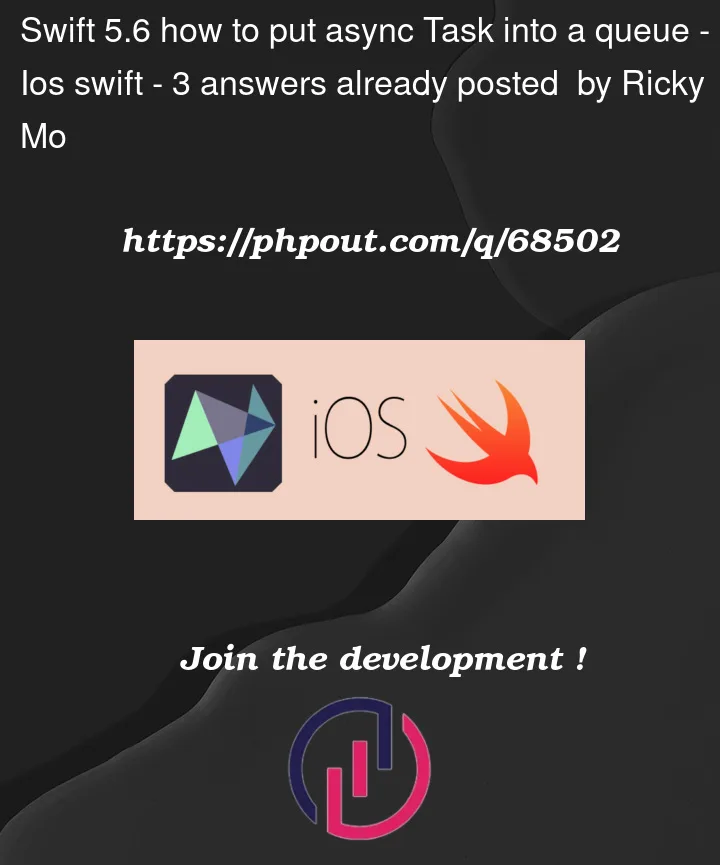Let say I have this code
class Duck{
func walk() async {
//do something
print("walk start")
try? await Task.sleep(nanoseconds: UInt64(2e9))
print("walk end")
}
func quack() async {
//do something...
print("quack start")
try? await Task.sleep(nanoseconds: UInt64(2e9))
print("quack end")
}
func fly() async{
//do something
print("fly start")
try? await Task.sleep(nanoseconds: UInt64(2e9))
print("fly end")
}
}
let duck = Duck()
Task{
await duck.walk()
}
Task{
await duck.quack()
}
Task{
await duck.fly()
}
This would print
walk start
quack start
fly start
walk end
quack end
fly end
which I understand and expected. But what if I want those 3 Tasks run sequentially? Let say each Task is created by user pressing a button. I want the tasks to queue up in the background and run one by one. Is there any thing like you can queue up DispatchWorkItem in a DispatchQueue, but a Task version?
Edit:
I came up with a solution, but I am not sure if this is a good way to implement it. As this implementation potentially create many layer of cascaded Task, I wonder if there would be risk of stack overflow or memory leaks?
class TaskQueue{
private var currentTask : Task<Void,Never> = Task{}
func dispatch(block:@escaping () async ->Void){
let oldTask = currentTask
currentTask = Task{
_ = await oldTask.value
await block()
}
}
}
taskQueue.dispatch {
await duck.walk()
}
taskQueue.dispatch {
await duck.quack()
}
taskQueue.dispatch {
await duck.fly()
}




3
Answers
Update:
For future people who find this post useful, I have created a swift package with better implementation and added support for queuing up
AsyncThrowingStreamtoo.https://github.com/rickymohk/SwiftTaskQueue
Here is my updated implementation which I think is safer than the one I posted in the question. The
TaskQueueActorpart does all of the job, I wrap it with an outer class just to make it cleaner when calling from a non-async context.I found this one on Github: https://github.com/gshahbazian/playgrounds/blob/main/AsyncAwait.playground/Sources/TaskQueue.swift
via
https://forums.swift.org/t/how-do-you-use-asyncstream-to-make-task-execution-deterministic/57968/18
Seems to work
I once was a proponent of the unstructured task approach, where each would
awaitthe prior one. In retrospect, this feels a bit brittle to me. Increasingly (with credit to Rob Napier for nudging me in this direction), I now use asynchronous sequences, specificallyAsyncChannelfrom Apple’sswift-async-algorithms. I think it is a more robust behavior and is more consistent with the asynchronous sequences of modern Swift concurrency.Before we come to your example, consider this serial downloader, where we have one process (the user button clicking) send
URLobjects to another process monitoring the channel for URLs in afor–await–inloop:We start
monitorDownloadRequestsand thenappenddownload requests to the channel.This performs the requests serially (because
monitorDownloadRequestshas afor–awaitloop). E.g., in Instruments’ “Points of Interest” tool, I have added some Ⓢ signposts where I clicked these buttons, and show intervals where the requests happen, and you can see that these three requests happen sequentially.But the wonderful thing about channels is that they offer serial behaviors without introducing the problems of unstructured concurrency. They also handle cancelation automatically (if you want that behavior). If you cancel the
for–await–inloop (which the.task {…}view modifier does for us automatically in SwiftUI when the view is dismissed). If you have a bunch of unstructured concurrency, with oneTaskawaiting the prior one, handling cancelation gets messy quickly.Now, in your case, you are asking about a more general queue, where you can await tasks. Well, you can have an
AsyncChannelof closures:E.g.:
That yields:
Here again, I am using Instruments to visualize what is going on. I clicked the “red”, “green”, and “blue” buttons quickly, in succession, twice. I then watched the six corresponding intervals for these three second tasks. I then repeated that six-click process a second time, but this time I dismissed the view in question before they finished, mid-way through the green task of the second series of button taps, illustrating the seamless cancelation capabilities of
AsyncChannel(and asynchronous sequences in general).Now, I hope you forgive me, as I omitted the code to create all of these “Points of Interest” signposts and intervals, as it adds a lot of kruft that really is not relevant to the question at hand (but see this if you are interested). But hopefully these visualizations help illustrate what is going on.
The take-home message is that
AsyncChannel(and its siblingAsyncThrowingChannel) is a great way to remain within structured concurrency, but get serial (or constrained behavior, like shown at the end of this answer) that we used to get with queues, but with asynchronous tasks.I must confess that this latter
AsyncClosureexample, while it hopefully answers your question, feels a little forced to my eye. I have been usingAsyncChannelfor a few months now, and I personally always have a more concrete object being handled by the channel (e.g., URLs, GPS locations, image identifiers, etc.). This example with closures feels like it is trying just a little too hard to reproduce old fashioned dispatch/operation queue behaviors.